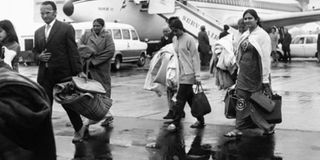Puzzling ‘mass migration’ of Ugandans to India

Ugandan Asians arrive in the UK after being expelled by Idi Amin in 1972. More than 50,000 Asians were expelled at the time. Courtesy Photo
India- The latest census data on migration to India says the number of people from Uganda living in India has risen rapidly, by tens of thousands of people. Migration expert Chinmay Tumbe explains why this is likely to be the result of a major bungle by officials.
Indians have had a long connection with Uganda.
In the 1890s, around 40,000 Indians, mostly Punjabis, were brought in as immigrant workers to build the Uganda Railway connecting Mombasa in Kenya to Kampala in Uganda.
They were forced to leave the country in 1972 on the orders of military ruler Idi Amin, who accused them of “milking Uganda’s money”. (Many of them returned to Uganda in the 1980s and 1990s, and became a pillar of the country’s economy.)
Both these aspects were captured in Hollywood dramas such as The Ghost and the Darkness (1996) and The Last King of Scotland (2006).
Now, in 2019, a third connection has been established between India and Uganda - and rather dramatically, it has come from a 2011 Census of India. The exhaustive exercise is conducted every 10 years, but some of the data is being released only now.
India’s population grew by 181 million people to 1.21 billion over the decade to 2011, according to the census.
As per the recently released migration statistics, the number of Indians who reported Uganda as their last place of residence shot up from 694 in 2001 to 151,363 in 2011.
The rise was starker among women - 339 to 111,700 - than men - 355 to 39,663.
After the regional nations of Bangladesh, Nepal, Pakistan and Sri Lanka, it is Uganda in Africa that appears to be the source of the highest immigration or return migration to India. This could either refer to Ugandan nationals who have moved to India or Indian nationals who were living in Uganda and have returned.
Numbers questioned
Unlike a century ago, the Punjabi connection is minuscule. In the northern state of Uttar Pradesh and the eastern state of Bihar, the number of Ugandan immigrants or return migrants rose from five in 2001 to 94,704 in 2011.
These numbers point to either a major census data goof-up or one of the most remarkable unreported sociological phenomenon of our times. Two clues give it away.
First, it’s the simplest explanation for the massive gender imbalance in the numbers.
Also, more than 77,000 of these Ugandan immigrants/return migrants reported that they had been in India for more than 10 years. But the 2001 census registered only 694 such people in total.
So it’s far more plausible that there was a mistake.
BBC



